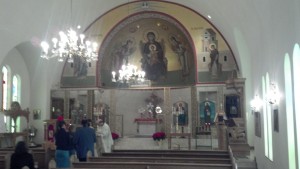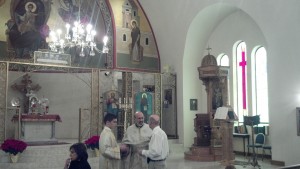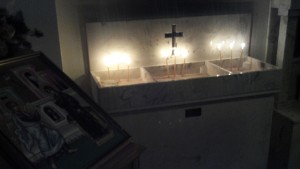Church Experience #46 – December 4, 2011
Annunciation Greek Orthodox Church – Chattanooga, TN
Bucket List
Everyone has things about themselves that they are disappointed in. Things that you know you should have done, places you should have gone, subjects you should have studied, books you should have read, actions you should have taken, opportunities you may have missed…the list goes on and on. We are all afraid (maybe to different extents) of coming to the end of our lives and saying the words “I should have ______, but I never did. I wish I could go back and do things differently”. Some of the things may seem small and insignificant to us in the present moment, so we keep putting them off thinking that we will have time to take care of them later. The problem is, none of us knows how much time we actually have left before we move on to the next realm. Today could be our last day here. So how do we prioritize and get the things done that we actually want to do? How do we even identify the things that could be those “Bucket List” type regrets? I believe that I need to weigh things out by testing them against the Bible and the life that Jesus lived. What would be a more likely thing for me to say with my last breath…”I should have gone skydiving,” or “I should have spent more time with my family”? I personally believe the latter is more likely (for me at least). That is an extreme example, but take a moment and scale that back to situations that are actually a part of your everyday routine. What would you be more disappointed in missing out on…the latest episode of “CSI: Miami” or an hour of time praying for the needs of friends and family who you know have major issues going on in their lives that could be healed or solved through God’s intervention? I think about these things often, and feel pretty guilty about the way I use my time. Time is one of the resources that we are given by our Creator that we are expected to be good stewards of…just like our physical strength, talents, wealth, etc. So how can I use the ChurchSurfer blog project (which I believe is a pretty good use of time) to also help me do some other things that are important to me? I have always had a desire to learn more history, specifically the history of the Christian faith and churches over the years since our Savior’s life, death, and resurrection. Protestantism and Catholicism are two pieces of modern Christianity that I have already experienced first hand, but there is another that I have left out up to this point. It’s time to fix that, so I decided to visit Annunciation Greek Orthodox Church and begin to explore Orthodoxy. Here’s how it went…
Breathtaking Beauty

Neither Laura nor I had ever been to an Eastern Orthodox church before (in fact, the extent of my experience with Orthodoxy was drinking coffee at the Alektor Cafe when I used to live in Nashville), so we really had no clue what to expect other than a notion that it might be similar to a Catholic service, which we had experienced earlier in the year on Easter Sunday. So with that we showed up ready to see what we might bring away from this new experience. Upon walking in the front door into the lobby, we saw immediately to our right a table where “prayer candles” were available for a donation, which could be lit and pushed down into sand (I think) that filled a small shrine…an act that was done with the purpose of offering prayers for loved ones. There were a few people standing in the lobby and we could hear singing coming from within the sanctuary, so we hesitated a little, not sure if we should enter the room while something was going on. A college student saw us and came over to greet us and ask if we were visitors, to which we affirmed, so he graciously took the liberty to begin explaining what was going on and how we could follow along with everything. He explained that the priest, Rev. Stavros Ballas, was the one who was chanting Psalms inside the sanctuary, which served as the opening to the service. The young man pointed out a red book that was inserted behind each pew (just like a hymnal) called “The Divine Liturgy of Saint John Chrysostom”, which would allow us to follow along throughout the service. He welcomed us warmly along with another lady who was in the choir, and let us know that should we have any questions, Rev. Ballas would be more than happy to answer them. We waited for a few more minutes inside the lobby, and as other people came in and entered the sanctuary, we decided to go on inside and take a seat also. The sanctuary was breathtaking. It was a large white monastery-style room with a large decorative dome at the front that was too ornate to even describe. The inside of the dome ceiling was painted with angels and God the Father with Jesus in the traditional Orthodox style, and below the dome was a golden gate that separated the front of the stage area from the back (which I’m assuming only priests are allowed to enter). The gate had a doorway on either side and a large opening in the center, through which you could see an altar table with a gold and silver cross and ornaments around it and then almost hidden further behind the altar table was a wooden cross and crucifix. There was a painting of The Last Supper at the top of the gate, and a few poinsettias and Christmas wreaths adorned the white marble stage, which had golden lampstands, candles, the priests’ podium, and large ornate structures for various parts of the ceremonies. I sat and thought to myself that I could probably be here all day looking at each intricate detail of the sanctuary and never get bored…it was beautiful.
A Little Hard to Follow

A choir singer began an a capella chant from the choir area, which was hidden from sight in the balcony behind the congregation, and the people in the congregation sang responses in unison. The voices from the choir echoed around the room, which had architectural acoustics that eliminated the need for electronic amplification. I breathed in the strong smell of incense and listened as the priest and his assistant (altar boy?) read a Gospel reading from Luke and then an Epistle reading from Galatians. Laura and I struggled to find our place in “The Divine Liturgy” book so that we could follow along, finally figuring it out about halfway through the service. What had thrown us off was that much of the service was done in Greek and then repeated in English. The priest called all of the children to the front for a children’s sermon about Saint Barbara, and after dismissing them went back through one of the side doors of the gate and proceeded out from the center entrance with a golden incense shaker which hung from his hand by a chain with bells on it. He ceremoniously waved the incense shaker three times toward a painting of Jesus on one side of the entrance and then three times at a painting of Mary on the other side. He did this routine three times and then waved it at various angles toward each part of the congregation. The priest then began a procession around the side of the congregation and back down the center aisle with the sacraments for communion. Standing in front of the first pew, the priest, who was dressed in a ceremonial white robe with gold trimmings that completely hid his arms and hands anytime he lowered them down to his sides, gave a short sermon about how our society lacks belief in the spiritual realm and how most people do not believe in the existence of Satan. He explained the difference between demons (which are evil) and spirits (which implies neutrality), and how fortune tellers and occultists may believe what they are doing is communicating with harmless spirits when they are actually being deceived by demons. Rev. Ballas then made a pretty thought-provoking point that I was surprised I had never really considered before. He said that there is no “source” of evil. I guess he was saying that in the same way that there is no such thing as “cold” or “dark”, but rather only the absence of “heat” and “light”, the definition of evil would be the absence of good, or of God’s love and His will. Interesting stuff…I’ll have to look into it further. I would assume most of us just figure that Satan himself is the source of evil, but it makes sense that he only possesses the power that God allows him and that going against God is evil, which does not necessarily have a “power” or “source” behind it, so to speak. Communion was served after the sermon, and just like our experience at the Catholic church, it was only offered to those people who were members of the Orthodox faith (which judging from the participation, was less than half of the congregation). At the closing of the Divine Liturgy service each person in attendance was invited to greet the priest and receive a piece of bread as a gift, so Laura and I did and were able to have a quick conversation with him during that time.
Due Diligence

After the Divine Liturgy service, we were invited over to another building for coffee and refreshments (the college guy said “we’re Greek, so there’s always food involved”). We were happy to accept and enjoyed some Greek cookies, which were some type of shortbread cookie hidden under a small mountain of powdered sugar…delish! We strolled around the room and said a few quick hello’s and then decided to head home. On our way out, we were stopped in the parking lot by the priest’s wife and the young college guy and had a pretty informative conversation about the history of the Orthodox church, the Great Schism between Eastern Orthodox and Roman Catholic, and other ditties of Christian history. It became apparent very quickly that these issues were still a big deal to those in the Orthodox church. It is their belief that they have never strayed, parted, or divided since the original churches founded by the Apostles and that they still strictly adhere to the earliest established church doctrine, the Nicene Creed, which was adopted at the First Council of Nicaea in 325 A.D. While talking to them, it struck me that as Protestants, we (or maybe just me, I don’t know) often take for granted the history of the church and how we got to where we are. We hear about Martin Luther, John Wesley, John Calvin, but we probably know very little about what, why, and how they did the things that made them historical figures. As Protestants, we typically go free-wheeling along focused on the here and now, without any real sense of connection with the original Apostles and the early church that compares to the doctrine of Apostolic succession which is held by both the Orthodox and Catholic churches. I believe the widely accepted Protestant doctrines of Sola Scriptura (the Bible, not church traditions or interpretations, is the final source of authority for Christians) and Sola Fide (salvation comes from faith alone in Jesus as the Christ, not from good works), but I do not think I have done enough to explore the major differences between Protestantism, Catholicism, and Orthodoxy as it pertains to church structure, leadership, worship, tradition, and other aspects of doctrine. I don’t know about you, but I feel like these are things I need to explore and find out. If I am going to claim to be a Protestant, shouldn’t I fully understand what makes a Protestant a Protestant? So here’s to what I am sure will be a big part of my Bucket List, New Year’s Resolution, or whatever you want to call it for the year 2012…I will perform my due diligence in researching these things, which at the very least will give me concrete talking points for when I am faced with people who have questions. May God give all of us the wisdom and understanding to lead searching souls in the right direction…towards Him through faith in His son Jesus. Amen.

If you enjoyed this article, please click the Google +1 button at the top or bottom of the page to help others find it also.
Please share the ChurchSurfer blog with anyone you know who may be interested, and I also invite you to connect on Facebook and Twitter. Please post comments below, and you can email me directly at josh@churchsurfer.com.
Grace and peace in Christ,
Josh Davis

The Eastern Orthodox Church (officially the Orthodox Catholic Church) and the Roman Catholic Church are very similar in many beliefs and practices. I went back and re-read your experience at St. Jude and found that the overall tone of the piece and your experience at the church was much different than this one despite the similarities in beliefs and worship. Why do you think that is?
Ben, I actually thought about that quite a bit while writing the Orthodox article and remembering back to the Catholic article. I think there are a few things at play here. I was definitely apprehensive going into the Catholic experience, partly because growing up in a Protestant church has conditioned me to have certain “baked in” notions about the Catholic faith. I tried to go in with an open mind, but unfortunately the experience that I had was very cold and impersonal and somewhat reinforced those apprehensions, which translated into the tone of the article. My experience at the Orthodox church, however was quite the opposite. I was dealing with very little “pre-conditioning” concerning Orthodoxy…my guess is that it just isn’t talked about as much in the South. I was also welcomed in very warmly and personally and had people taking the time to explain different aspects of their service and traditions and how I could follow along. They took the time after the service to have a very real conversation with me about their feelings toward both Catholicism and Protestantism, which I respected. Lastly, keep in mind this blog is more about my experiences at churches as a first time visitor, not about correctness of doctrine, interpretations of Scripture, or relevancy of traditions. I hope that helps clarify, but I’m always ready to answer more questions if needed. Thanks for reading and for taking the time to comment!
Dear Mr. Davis, thanks for the very kind and interesting piece on your experience with Annunciation Greek Orthodox Church.
I remember my own first experience in a very similar manner almost 20 years ago, and now this former Pentecostal pastor is a Greek Orthodox priest.
May God bless your discovery and exploration of the beautiful and messy and challenging history of the faith “once delivered to the saints.” And Merry Christmas.
Thank you Barnabas! Pentecostal to Orthodoxy sounds like a very interesting change in direction. Merry Christmas to you as well, and thank you for reading :)!
Excellent article, Ben.
I am the Executive Director of ComeOnLetsGo and also a member of St. Tikhons Orthodox Church in Chattanooga, which was formed in cooperation with Annunciation to provide an English-only mission for Chattanooga (and our roots are more Russian than Greek).
Here’s a post I wrote recently on the subject.
http://coolbloobridge.com/?p=239
Thanks Dean! I’ll have to come check out St. Tikhons sometime…the Greek language definitely made it difficult to follow along at Annunciation, but the experience was well worth it. Thanks for posting your blog, I will definitely check it out. (BTW…my name is Josh, not Ben 🙂 )